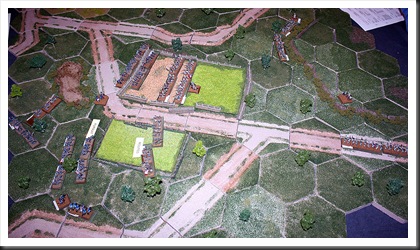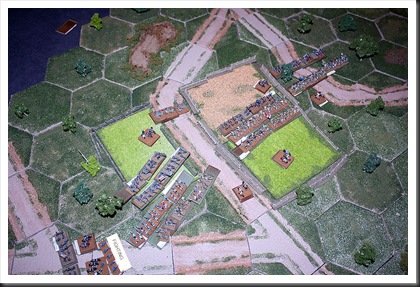Last Sunday I had an opportunity to run Belmont again. I made small adjustments to the terrain - addition of one more row of hexagons in front of Confederate camp was the most significant – but otherwise it was exactly the same setup as in previous game.
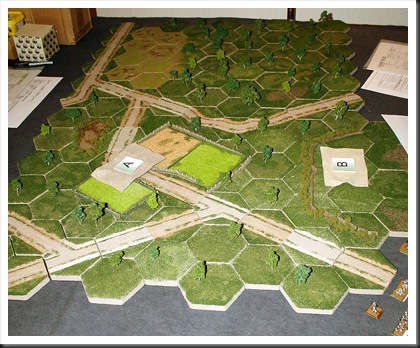
Terrain setup for second attempt at Belmont
More significant changes were made to OOB:s – I decided to drop rating of all units one step, which meant that almost all regiments became Raw. This is the lowest quality class in TCHAE and as it turned out, this change had significant impact on the game.
Since the first game showed clearly that the Union side had a very tough objective in this scenario, I asked L. to make a repeat appearance as general Grant. Confederate army was this time run by H. and P. taking one brigade each. H. also assumed the role of confederate CinC, general Pillow.
Different players – different battle
Second run of Belmont scenario was quite different from the game between me and L. Initial dispositions of Confederate forces were however rather similar to mine. The only difference of importance was the fact that H. decided to place his larger brigade in the field in front of the camp and retaining P.’s smaller brigade in the camp. It did however signal to L. that this time around the Rebels would probably be more agressive in their defence.
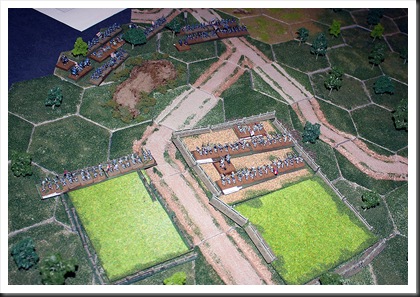
Union brigades deploy for assault
L. remembered the difficulties he run into in his first attempt at Belmont and decided to concentrate his scant forces before assaulting the rebel line confronting him in the field. I have to say that his attack definitely had a proper ACW feel to it. He put two regiments in front, two regiments as supports, allowed time for short artillery shelling that disrupted one of raw Confederate regiments and then smashed his infantry into Confederate position in the field. Southerners did their best to stop that advance and did cause some casualties on the Union regiments, as they closed the distance. In the end however, the forward momentum of both Union brigades was unstoppable. In a matter of two turns, Confederates lost their artillery battery (more on that later), while all of their infantry was routed and running toward their fortified camp.
Then something strange happened – despite the complete chaos in the rebel ranks, a single round was all it took for their officers to stop the seemingly unstoppable rout. Somewhat unfortunate draw of cards (if seen from Union perspective) and a very opportune arrival of additional Rebel regiment helped to stabilize the situation even more. Regardless of the intervention of 'Lady Luck', all of us were very surprised by TCHAE allowing such easy recovery from a situation that seemed irrecoverable just two turns before.
By that time our game was nearing its end and it was quite evident that despite L.’s initial success, he would not be able to break the Confederate lines before the appearance of the rest of their reinforcements. H., emboldened by that knowledge and the fact that P.’s brigade finally came up to protect his right flank, decided to make the final effort before we called it a day. He threw his recovered regiments into an all or nothing assault against battered Union regiments, with mixed results. His raw units in the center failed miserably to make an impression on L.’s single regiment of better quality and routed once more. Assault on left flank fared much better and managed to push the blue line back in disarray.
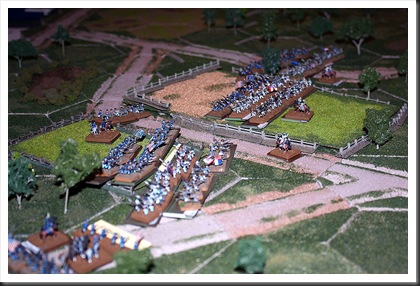
End of the game from another perspective…
Just because I like that picture. :-)
All of us knew however that this last action of the day was unnecessary and should be considered more as a rules test than part of the game. The game was decided when initial Confederate rout was stopped on a dime – an event that for a moment made me doubt if I wanted to continue to use TCHAE as the ACW rules set for our group.
Musings after the game – improved and this time far to long
Until our last game, I was rather enthusiastic about TCHAE. Now however, I do feel that TCHAE does deserve some serious criticism.
Remember that Confederate battery that was lost in the initial contact with Grant’s force? What happened there was that the rebel battery was in front, while supporting infantry regiments were behind it. In game terms, the battery took the full brunt of Union assault. Despite my best efforts, we couldn’t find any rules that clearly covered a situation where artillery received infantry charge all on its own. In the end, after looong deliberations, we managed to interpret relevant rules and came to the decision that the battery was overrun and its supports had to retire. However, if I am to be perfectly honest, it was more common sense than the rules that guided us to this conclusion. Later, I posted a query about this issue on TFL Yahoo Group, which usually is great at clearing up this sort of questions. This time around, my question seemed to leave most members stumped. From that fact alone, I draw the conclusion that the part of TCHAE that deals with assaults could use some editing and additional explanations.
My main criticism is however reserved for the way in which TCHAE handles routs and rallies. Sunday’s game was the first time we had the opportunity to “study” TCHAE’s interpretation of this significant part of the game and unfortunately we weren’t very satisfied with what we saw.
Now, let me be perfectly clear here – I am fully aware that opinions of this sort are highly subjective and will differ widely from player to player. For that reason, let me explain how I understand the concept of rout: it is a state where majority or all soldiers of a unit no longer have the will to fight and are mainly concerned with their personal safety. Unit cohesion is dissolved and authority of the officers is reduced or maybe even disappears completely. In simple terms, units in rout run for their lives.
In game mechanics terms, it translates in my opinion into two things – any contact between routed unit and organized enemy reinforces the rout and will in the end lead to complete dissolution of the unit. Furthermore, a rally of a unit in rout state should always be unsure and under some circumstances even improbable.
The way TCHAE handles this very complex situation is very simple, if not simplistic – it is enough to spend one commander’s PIP:s (or more, if commander is beyond default command range) and the routed unit will always stop running. That’s it. If considered from my perspective, such handling of routs/rallies is highly unsatisfactory. The fact that under right circumstances, routed units don’t even have to “run”, but can be stopped in their tracks almost immediately after entering rout state, makes my concerns about the rout/rally rules of TCHAE even more serious. As for any effects of effective enemy fire on a routed unit, there simply are no rules that deal with such situations.
As I mentioned above, those “faults” gave a momentary pause to my until now unchecked enthusiasm regarding TCHAE. Does it mean that I will stop using the rules set? Absolutely not. Last Sunday’s game was in most respects a very pleasant experience. L’s deployment of his forces and his initial assault did remind me of descriptions from books about that conflict. In general terms I’m becoming more and more convinced that TCHAE is a sound rules set with great period feel and complexity suitable for our group. At the same time, I can't deny that the way TCHAE handles routs/rallies did receive substantial flak after the game and will require some serious tinkering to suit our taste.
Of course this is the opinion of just one wargamer, backed up to a degree by comments from a small group of wargamer friends. So please, feel free to agree or disagree. Also, I would greatly appreciate any help or comments in regard of rules questions in this post.
I guess that in the end, this far too long musing is yet another proof of the fact that it is impossible for a ruleset to suit all players and that we can't help ourselves to "improve" on even the best efforts of game designers. After all, what rules set survives its first contact with the players?
